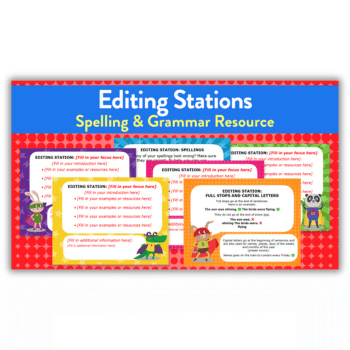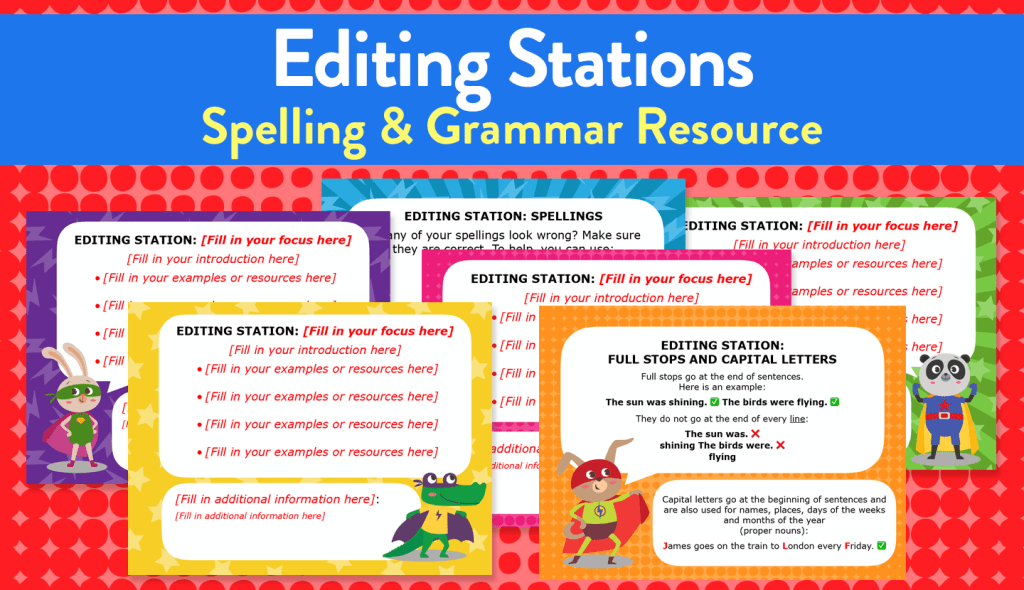What’s the fuss about editing stations?

How on earth can we get children to properly check their work? This may be the answer…

- by Ashley Booth
- Year 6 teacher and AHT Visit website

There’s always one question at the forefront of educators’ minds when it comes to the teaching of writing: how on earth can you get children to properly check their work?
We’ve all tried a plethora of methods: line by line using a ruler; peer checking; pulling out your hair and exasperatedly asking little Timmy to check it again and ‘see if it makes sense’.
How can we make this process easier for our children? One method my school has been testing across all year groups is editing stations, and they seem to be doing the trick.
The premise is easy: you take the taught features from your genre and dedicate a ‘station’ to the checking of these.
I use separate tables for this and ask the children move in a carousel style, but I’ve also seen teachers using lanyards instead of asking their rowdy class to move around.
Alternatively, dot your stations around the playground to inject a bit of fresh air into your lesson. You’ll need to dedicate a whole session to editing after you’ve done your extended write.
How does it work?
Here’s an example to explain how it works.
If you’re teaching narrative in Y4, you might be working on fronted adverbials, embedded relative clauses and the use of direct speech, while also honing the finer points of whichever genre you are teaching.
These different focuses will make up the basis of three of your stations. My suggestion is to have six stations in total so the process doesn’t become too laborious or tiresome for the children.
In Y4, you might also have a spelling station, a full stops and capital letters booth, and one table focusing on the actual content.
For example, in a recent teaching sequence on writing horror, I had a ‘suspense station’, where the children considered how they were building suspense in their writing.
Free editing stations download

Download a free set of editing station cards that you can personalise.
So how does it work in practice? Well, children take their books and simply visit one station at a time. Begin a one-hour lesson by clearly modelling the process.
To do this, visit the fronted adverbials station with an example of writing that would benefit from the addition of one.
Display the writing on the board and explain that in this station we are only looking at our work to check that, firstly, we’ve used fronted adverbials and, secondly, they are an effective way to add description or information to our text.
This is probably a 10-minute process, and you’ll also want to leave yourself around eight minutes at the end to want to wrap up the lesson in some way, so accounting for transition and settling between stations you’ll need to give children around six minutes to complete each assigned task.
Once the children are buzzing around the stations, it shouldn’t be too difficult to direct your time towards those who need it. Take a step back and listen to the conversations happening.
This will help you to quickly intervene if you hear any misconceptions. You should also consider laying out some information cards or resources on each table.
The spelling station is the easiest for this, with a dictionary being the obvious choice, but in a general vocabulary lesson you might also include a descriptosaurus, glossary or thesauruses.
Year group specifics
For Y1, you might include a ‘how to’ guide for using full stops that shows that they go at the end of sentences, with an example featuring full stops at the end of lines which is clearly marked as incorrect.
In Upper KS2 you can crank up the difficulty on a passive voice station by simply giving pupils an explanation of how the passive voice is used, without an explicit example.
Instead, include a short piece of text that uses it effectively. This encourages children to independently work out how to include this feature in their writing.
For Y6, you might have a general punctuation table without any examples, where children check for capital letters, full stops and commas. Their understanding of these features should be a given at this stage in their education.
Ultimately, it’s best not to over-support if at all possible.
If a child hasn’t used a particular device in their writing, they may simply not understand it, so you might instead benefit from spending time reteaching fronted adverbials before your next big write, so pupils are equipped to make the appropriate edits when they get to the task.
Simply leaving information on an editing station that tells a child that a fronted adverbial goes at the front of a sentence with a comma won’t lead to him or her immediately grasping the concept.
The flipside of this is to not be too vague. I’m aware that this is not an entirely helpful statement, but it’s all about finding the balance.
If you’ve been teaching Y1 how to write and your station only features an A4 piece of paper featuring the words ‘full stops’, poor Omar, who still hasn’t grasped they don’t come after every single word, may as well spend the assigned six minutes practising handstands.
Always improving
The final thing to consider is improvement. We all have at least pupil in our class who is a great writer.
When Joseph in Y4 gets to the fronted adverbial station he might thinks he’s quids in because he already understands them and can chill out for the next six minutes. Wrong!
How can Joseph improve his fronted adverbials? How can he use them to affect the content of his writing? Can he write on a separate sheet why his choices are effective? Can he explain to a peer why their choices are or are not effective?
One of the main benefits of editing stations is that they nurture independent writing and improvement.
Children quickly learn that by focusing on improving one aspect of their work at a time, their writing quickly improves as a whole.
Pupils are too often left to merely scan a piece of work, supposedly checking for how to improve it, but merely end up simply replacing one word with an equally effective synonym, or remembering that ‘November’ needs a capital letter.
The other quickly noticeable benefit of stations such as these is an increase in peer editing and collaboration.
We all know that children are better at noticing mistakes in other pupils’ work (and yours, woe betide you make a mistake on the board), so organising them into small groups and focusing on one objective at a time really streamlines this process and helps children get the most out of it.
Ashley Booth is a Y6 teacher in Toxteth, Liverpool. Find him on Twitter at @mrboothy6 and visit his website here.










